The Airstream, with its iconic riveted aluminum shape, trends in cycles like history’s best fashion pieces – bomber jackets, wide leg denim, classic kicks. It’s on the upswing, enjoying a healthy resurgence in popularity thanks to wanderlusting millennials with vintage leanings. The apex of Airstream’s renaissance coincided about 10 years ago with a newly coined term: glamping. It’s camping with air quotes. Roughing it, for the squeamish and the pampered. Airstream’s simple, timeless vessels began to undergo extreme makeovers, emerging as luxury apartments on wheels.
A gutted Airstream is a blank canvas, and businesses were getting wise to its potential as a flexible pop-up shop or a moving showroom.
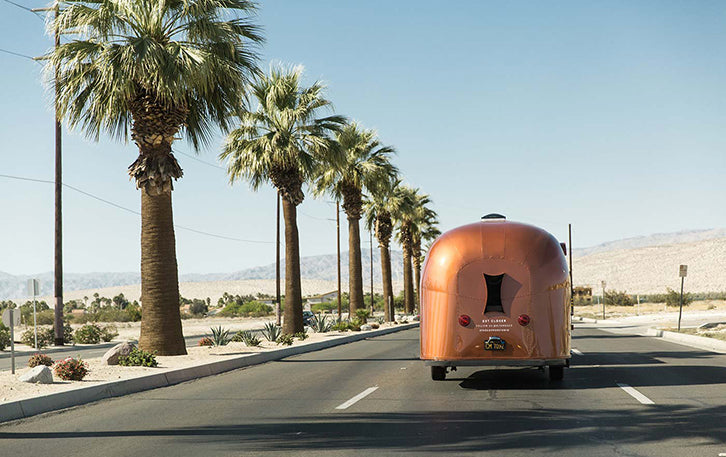
image: Kit & Ace
Kit & Ace’s copper Airstream studio is unmistakable – I spotted it last year along Toronto’s Queen Street West, before it was off on new adventures. (For the record, commercial leases on Queen average about $4000 CAD per month, but parking for a few peak shopping hours costs less than a latte.)
In Portland, an Airstream holds a tiny hair salon, cleverly coined The Hairstream Trailer, and in Dallas, it’s the nucleus of a cool food truck concept bar. The novelty is not lost on Airbnb hosts, the smartest of those jumping to set up inexpensive, gimmicky guest spaces for as much as $205 USD per night.


Images: Texas Truck Yard, Airbnb
This is the second post in our two-part series about Shopify merchants running businesses from the road. Last week, we shared the story of a serial ecommerce entrepreneur, boondocking off the grid. Read: Why Working From the Road is Good for Business
This week, our subjects are two makers glamping and retailing their way across America’s pop-up circuit in a renovated vintage Airstream studio.
Remember how we talked about the secret of running a business from the road? That success relied on automation and outsourcing, on building a well-oiled machine that runs itself? That warehousing products in a tiny mobile home would be nearly impossible?
I take it all back.
There’s more than one way to attack any problem. Even this one. When I was pursuing this story, this guide to retiring before you retire, if you will, the Taylor Banks template emerged as one that could be applied to a myriad of ecommerce businesses, those that could be farmed out in pieces, those run with your eyes closed and sunroof open. But what about the makers, the owners of physical businesses that need more hands-on love?
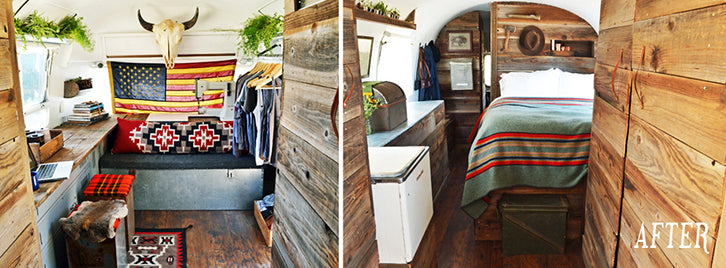
I happened upon an image of an Airstream interior makeover on Pinterest that led me down a DIY rabbit hole to a Design*Sponge post about the couple behind it. Remarkably, the duo happened to be running a business out of said Airstream, and they were using Shopify to power their store. I expected their story to add a nice contrast to my last post, but their journey and motivations were so starkly different than my first subject. They deserved their own stretch of the highway.
Mackenzie Edgerton and Blaine Vossler caught up with me from New York where they are now establishing roots. They’re coming down from a travel high after spending the last two years on the road, making and selling leather accessories, apparel, and lifestyle goods under their brand, The Local Branch.

“We moved to California at the time of the recession. We were creative people but couldn't really find creative jobs so we opened up an online shop as a small hobby business. From there, we grew it for a few years until we saved up enough money to travel. But we didn't want to drain all of our savings to do it. We had an idea inspired by food trucks – maybe we could do a mobile retail store. At the time, we really couldn't find any examples of anyone else doing it.”
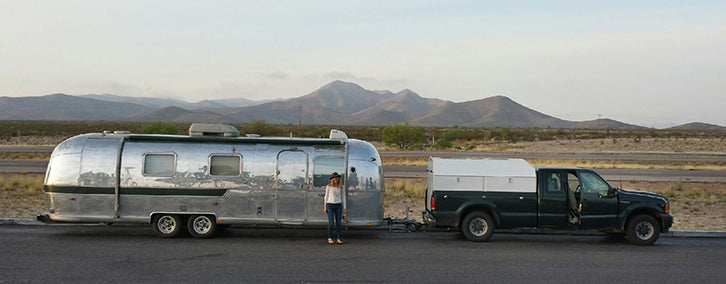
At the time, Blaine and Mackenzie were unaware that they were among the pioneers of the #homeiswhereyouparkit movement – a now massive community of young people ditching leases and desk jobs for life on the move. RVs, once as synonymous with retirement as Florida timeshares, have now been appropriated by the youth. Kids these days!
Sounds lovely, but how does one fund perpetual adventuring without a pension? The opportunities are growing, but the best answer is this: create your own. That’s when The Local Branch graduated from an online marketplace to its own home using Shopify.
“We're really creative – we know how to make things look good – but we don't know how to code. One of our friends in the ad industry told us ‘Shopify is really intuitive and you basically just plug and play’. It was the solution that we were looking for and it's been so easy ever since. We had a wi-fi hot spot for internet so that we could check our store daily do everything from the road that a normal business could.”
We were rebranding, creating the website, photographing our products, and running a Kickstarter campaign, all while we had regular day jobs.
Funding the Dream
In our first road warrior profile, we learned that Ace Hackware was viable and profitable before the owner decided to hit the road. For Mackenzie and Blaine, the road was beckoning but they still needed a little help with expenses, most notably the cost of buying and fixing up their studio on wheels.
The success of their Kickstarter campaign (they hit their $15K fundraising goal in a month) was largely due to a beautifully produced video that oozed Americana, and told a unique story. But it didn’t exactly happen overnight.
“We just put it out there into the world and kind of thought that magically we would get $15,000. But really, it was a lot harder than that. We didn't have the kind of connections that we have now, and even just explaining our idea to people was hard. It was a challenge to get people behind an idea that they didn’t even understand.”
The hardest part was convincing people that we weren't crazy.
“Luckily, we were set up for the Kickstarter format where you're giving rewards to your backers. That was really easy for us because that's what we’re doing: making stuff. Once we were funded, we could actually reward all of our backers quickly and get the project off the ground.”
Building a Brand
How can you enter an oversaturated market like printed t-shirts and accessories and achieve success? Sometimes, the edge isn’t the product itself but rather the story behind it. We’ve stressed the importance of a great About page, of finding a niche audience. For celebrities, it’s an easy formula: get famous, sell anything at any price to scads of drooling fans. (Are you buying a lipstick or a little piece of Kylie Jenner?)
Small businesses can apply this strategy in similar ways:
- Define your brand: is it one and the same with you personal brand? What makes that story unique? Does your audience aspire to be like you? Weave your story into product descriptions and ecommerce packaging.
- Choose your medium: build your audience by being authentic, and doing what you do best. Are you a natural writer? Tell your story through a blog. Is your audience the Pinterest set? Start there.
- Sell the lifestyle, not (just) products: Instagram and Snapchat are great outlets for telling the visual story of your brand, especially if you are central to that story. Show how your products are made, where you find inspiration. Engage in the niche communities where your customers live.
For The Local Branch, the story of where the products are made is as important as how they’re made. When you buy a leather holster, the tag may say “Made in Schenectady, NY” or “Made in Palm Springs, CA”, depending on where the Airstream was docked at the time.

The novelty of their vessel and their journey has helped them score press, too.
“When Design*Sponge picked up our before-and-after story, that coverage didn't necessarily contribute directly to sales, but it gave us a lot of exposure. Two to three years later, we still get people reaching out saying ‘I'm writing about the love of Airstreams’ because of that post.”
Everything in its Place
I confess to them about my craft room, my secret shame. About the way all of my projects explode into a nest of wayward threads and paint splatters and sawdust. This room, I tell them, is larger than the entire Airstream that they use to live, work, and create. How do they keep leather scraps and invoices separate from towels and condiments?
“We are creative people that love to spread out. But living in a small space, it felt crowded really easily, even if you just have one dish out it was like, well, that's most of your counter space. We spent a lot of time just following the sun so that we had that outdoor space to work. So Blaine would bring hides of leather out on the picnic table and be working out there so that the inside space didn't feel too crowded. We still had to clean up every night so that there was some comfort in our bedroom and kitchen, because everything is one space.”
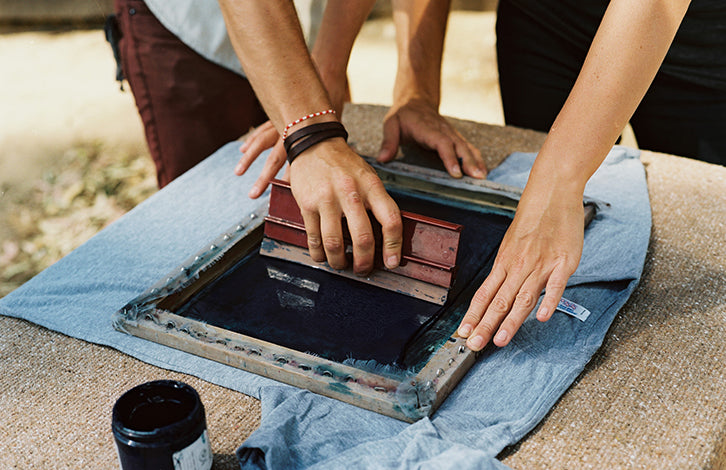
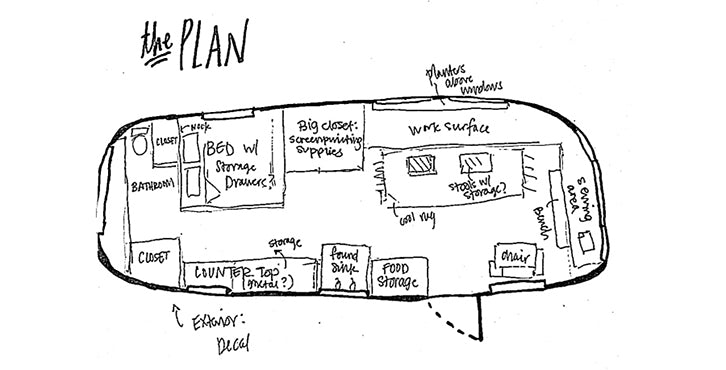
Hold up. You lived in a one-room space with your partner in love and business, and you’re still together? OK, spill.
“As a couple running a business together, we have to consciously force ourselves to not talk about business. It's so easy first thing in the morning to do just that. And we tried not to allow it to dominate our free time and our down time.”
There's not the same delineation that there was when we worked for employers – there’s no clear line between your job and your personal life.
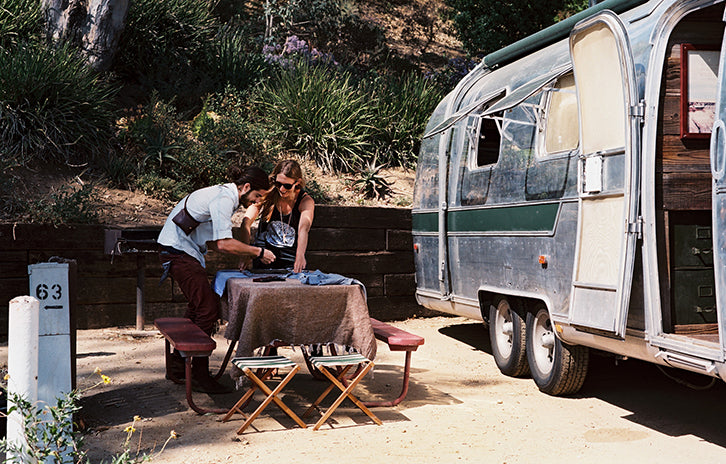
What of the other relationships? How do family and friends play into the life of two working nomads? It seems that running this type of business from the road relies heavily on a solid network of people willing to act as porters and postal depots to support the cause.
“One of the challenges is receiving shipments. When we order supplies, we would say ‘okay, in three weeks, we're going to be at my cousin's house in Southern California’. We’d have to tell people "you're going to have 10 boxes at your door – please open the garage for us". Family would be forwarding things for us so that we could pick them up – it was a lot of planning.”
Finding the Aluminum Lining
(See what I did there?)
Incoming packages weren’t the only challenge. Unlike Taylor’s hands-off fulfillment strategy, Mackenzie and Blaine personally shipped out packages to each of their customers. The two turned this very manual process into a positive, adding richness to the brand’s travel narrative with different postmarks plotting out their map.
“Out on the road, we would pack up our orders and go to the nearest post office,wherever we happened to be. Our first year, we were photographing every single post office and at this point, we've been to hundreds of them all over the country. We were once in Mesa Verde National Park in Colorado. They have a post office that is actually located pretty deep in the park, probably a 45 minute drive from the nearest entrance. It was this tiny, old school post office that still has mailboxes from the '20s. It was like stepping back in time.”
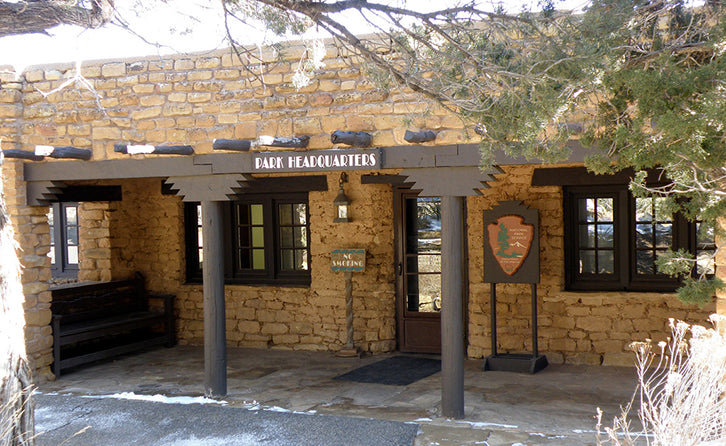
image: Southwest Colorado Heritage
We were like, ‘well, we hope our products make it’!
Getting Some Face Time
Another benefit of travelling with your stock, is the flexibility to pop up and connect with customers IRL. Blaine and Mackenzie followed the music. They organized their route around craft markets and vendor opportunities at music festivals across the country.
“When started in 2009, we hit the ground running with the Renegade Craft Fair in San Francisco and LA. The most valuable thing about selling in person is getting to meet all of our customers. We love hearing feedback and suggestions from customers. It is amazing what you can learn (about your business) just by observing people in your space!”
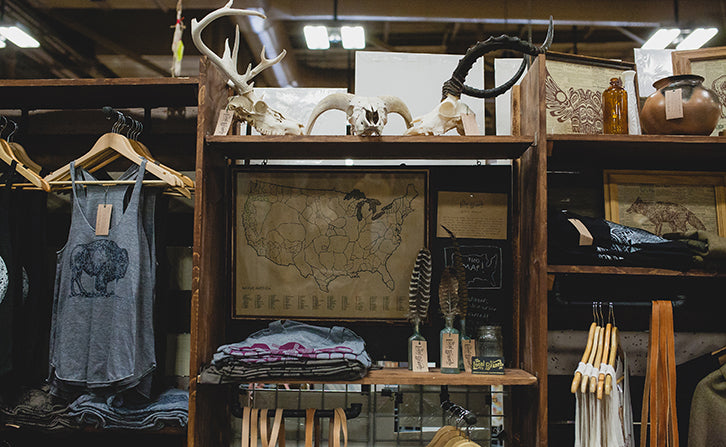
image: Renegade Craft Fair
With space limitation being a key factor, they worked on building a portable display solution that fit into their truck, and was simple enough to set up with two people in under two hours. It also had to reflect the brand and incorporate the elements of their story.
“To us, the display is just as important as the stuff we sell in it. We were really conscious of the materials we used to build it and wanted that to be a stamp that people would recognize.”
Scaling Up, Settling Down
It all sounds magical, doesn’t it? Here’s the downside of their business model: it doesn’t scale. I ran a handmade business through an online marketplace for ten years. It was essentially a hobby that paid for itself, and I intentionally didn’t grow it because I enjoyed every step from cutting fabric to making shipping labels. As a side hustle, however, I didn’t rely on it for income. For a bread and butter business like The Local Branch, scaling was the inevitable next step. They realized that it would be impossible to grow without first setting down some roots.
It's really hard to relinquish control when you're so used to doing every part of it.
The owners are now docked in Kingston, NY. The Airstream? It’s still in play as a means to travel the handmade market circuit this summer. The rest of the year, however, the business will thrive in a live/work loft space where Blaine and Mackenzie can automate more of their processes and hire more staff.
This week, The Local Branch set up a permanent booth in Chelsea Market.
“While hiring, we created an application that's different from a normal retail sales application, asking questions like: ‘what are your future goals? What are other skills do you have?’ We're not the best at social media so maybe one of our sales associates can lead that front. We can't always go to all the festivals – that’s an opportunity we can give to someone else.”
We want to hire like-minded people and build a team around skills that make us stronger.
What have I learned over the past few weeks about working from the road? It’s not for everyone (nor every business). Even glamping comes with sacrifice, and the challenges of starting a business from scratch are only compounded by unreliable internet and unpredictable weather. If, like me, you’re inspired by an ever-changing view, those challenges look a lot more like opportunity. Get out there.
“There are a lot of hardships we had to overcome – more than you would if you were running a business from the comfort of a home or an office, but definitely the rewards felt greater because of the risks that we took.”
Topics:
Join 446,005 entrepreneurs who already have a head start.
Get free online marketing tips and resources delivered directly to your inbox.
Thanks for subscribing
You’ll start receiving free tips and resources soon. In the meantime, start building your store with a free 14-day trial of Shopify.





